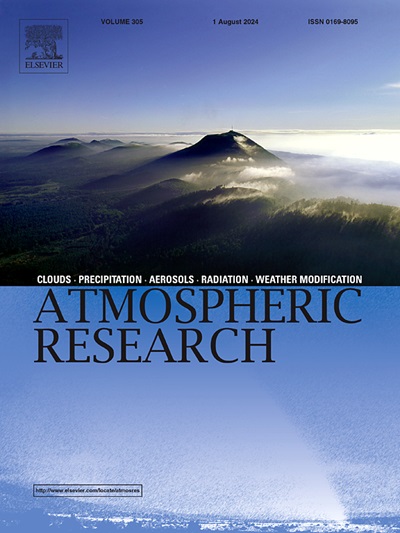Stacking machine learning model for precipitable water vapor vertical adjustment using GNSS networks and radio occultation data
IF 4.5
2区 地球科学
Q1 METEOROLOGY & ATMOSPHERIC SCIENCES
引用次数: 0
Abstract
This study presents a stacking machine learning (SML) model for vertical adjustment of precipitable water vapor (PWV), addressing missing water vapor information near the surface in radio occultation (RO) profiles and enhancing the accuracy of PWV estimation from RO data. The model is trained and validated using more than 1500 ground-based Global Navigation Satellite System (GNSS) stations and more than 320,000 RO profiles of the Constellation Observing System for Meteorology, Ionosphere, and Climate-2 (COSMIC-2) for two regions of the Northern hemisphere from January 2020 to December 2023. Results show that in the North American region, the SML model reduces the root-mean-square error (RMSE) of PWV estimates by 58.05 %, 36.99 %, and 33.05 % compared to conventional linear, exponential, and global PWV vertical adjustment (GPWV-H) models, respectively. In the region of China and Southeast Asia, the RMSE of PWV estimates is reduced by more than 42.9 %. External validation reveals that the SML-adjusted RO-PWV is in close agreement with PWV estimated from radiosondes and other RO products. Notably, the SML model outperforms conventional models across various latitudes and longitudes, making it well-suited for complex terrain and different climatic conditions. This study also examines the SML model performance for different climate types and extreme weather and proposes incorporating these factors in future work to improve model adaptability. Overall, the SML model excels in PWV vertical adjustment, providing a high-accuracy, fast solution for global PWV estimation, water vapor monitoring and weather forecasting.
基于GNSS网络和无线电掩星数据的可降水量垂直平差叠加机器学习模型
本文提出了一种用于垂直平差可降水量(PWV)的叠加机器学习(SML)模型,解决了射电掩星(RO)剖面中缺失的近地表水汽信息,提高了从RO数据估计可降水量(PWV)的精度。该模型在2020年1月至2023年12月期间使用北半球两个地区的1500多个地面全球导航卫星系统(GNSS)站和气象、电离层和气候2星座观测系统(COSMIC-2)的32万多个RO剖面进行了训练和验证。结果表明,在北美地区,SML模型与传统的线性、指数和全球PWV垂直平差(GPWV-H)模型相比,分别将PWV估计的均方根误差(RMSE)降低了58.05%、36.99%和33.05%。在中国和东南亚地区,PWV估计的均方根误差降低了42.9%以上。外部验证表明,sml调整的RO-PWV与无线电探空仪和其他RO产品估计的PWV非常一致。值得注意的是,SML模型在各种纬度和经度上都优于传统模型,使其非常适合复杂的地形和不同的气候条件。本研究还考察了SML模型在不同气候类型和极端天气下的表现,并建议在未来的工作中纳入这些因素,以提高模型的适应性。总体而言,SML模型在PWV垂直平差方面表现出色,为全球PWV估计、水汽监测和天气预报提供了高精度、快速的解决方案。
本文章由计算机程序翻译,如有差异,请以英文原文为准。
求助全文
约1分钟内获得全文
求助全文
来源期刊

Atmospheric Research
地学-气象与大气科学
CiteScore
9.40
自引率
10.90%
发文量
460
审稿时长
47 days
期刊介绍:
The journal publishes scientific papers (research papers, review articles, letters and notes) dealing with the part of the atmosphere where meteorological events occur. Attention is given to all processes extending from the earth surface to the tropopause, but special emphasis continues to be devoted to the physics of clouds, mesoscale meteorology and air pollution, i.e. atmospheric aerosols; microphysical processes; cloud dynamics and thermodynamics; numerical simulation, climatology, climate change and weather modification.
 求助内容:
求助内容: 应助结果提醒方式:
应助结果提醒方式:


